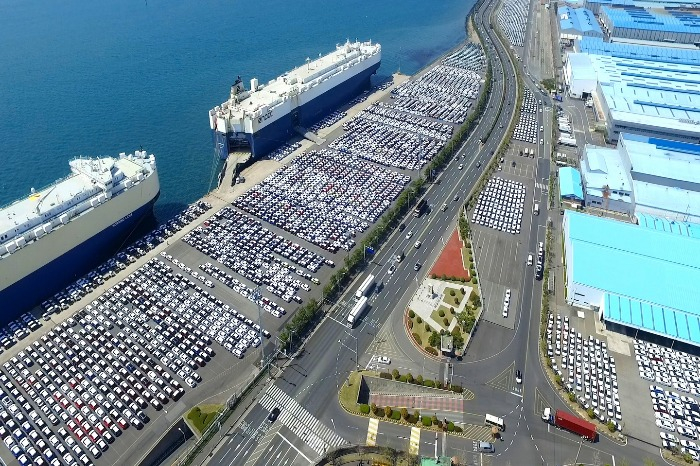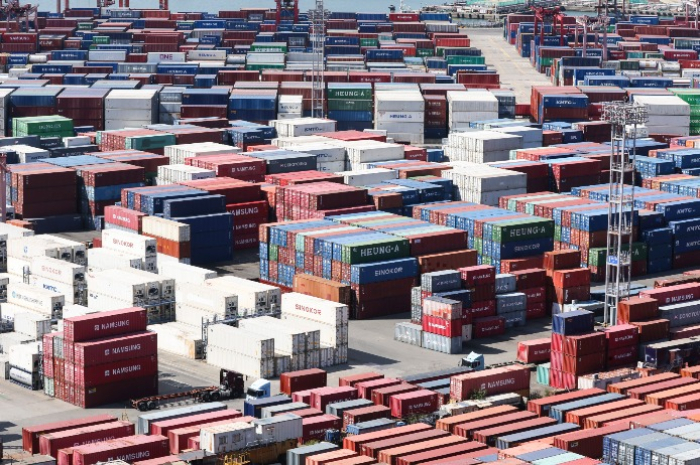Economy
Korea’s exports set to snap 12-month losing streak in October
Asia’s fourth-largest economy reported an on-year export gain in the first 20 days of the month on strong car exports
By Oct 23, 2023 (Gmt+09:00)
2
Min read
Most Read
LG Chem to sell water filter business to Glenwood PE for $692 million


Kyobo Life poised to buy Japan’s SBI Group-owned savings bank


KT&G eyes overseas M&A after rejecting activist fund's offer


StockX in merger talks with Naver’s online reseller Kream


Mirae Asset to be named Korea Post’s core real estate fund operator



South Korea may snap its 12-month-long losing streak in exports this month after it reported an on-year gain in exports in the first 20 days of October despite fewer working days thanks to brisk sales of its cars and ships abroad.
According to data released by Korea Customs Service on Monday, Korea’s exports from Oct. 1 to 20 amounted to $33.8 billion, up 4.6% from the same period last year.
After taking into account fewer working days over the period from a year ago – 13 days versus 13.5 days – the country’s exports in terms of daily average value added 8.6% on-year, heightening expectations that Asia’s fourth-largest economy would escape from its year-long downward exports spiral in October.
Korea has reported an on-year fall in exports since October 2022.
The daily average exports grew fastest in the cited period after the first 20 days of July last year with 13.3%. The daily average exports also hit the highest value of $2.6 billion during the period after April last year with $2.3 billion.
If Korea’s exports continue to rise at the current pace for the rest of this month, Korea would report an on-year increase in monthly exports for the first time in 13 months after September last month with a 2.3% gain, according to an official from Korea’s Ministry of Economy and Finance.
The drop in the country’s exports in September also slowed, raising hopes for a recovery in its economy.
Exports are Korea’s main growth driver, and their recovery is key to the country's economic growth.
TRADE DEFICIT
The pickup in the country’s exports in the 20-day period this month was mainly driven by a 24.7% on-year jump in outbound shipments of Korean cars and a 63% surge in vessels.
Exports of petrochemical products and wireless telecommunication devices also rose 14.5% and 6.1% on-year, respectively.

But the country’s other mainstay export item, semiconductor exports, dropped 6.4% over the same period, extending their losing streak for the 14th consecutive month.
The higher international oil prices also led the country’s imports over the same period to increase faster than exports, leading Korea to log a trade deficit.
Imports in the Oct. 1-20 period reached $37.6 billion, up 0.6% from the same period last year. Korea reported a deficit of $3.7 billion in trade, bigger than last month’s shortfall of $488 million.
Korea’s crude oil imports jumped 30.5% over the same period to $6.2 billion, the biggest since the first 20 days of August last year.
Petrochemical and precision machinery imports also increased 35.9% and 8.9%, respectively. But semiconductor imports decreased 3.3%.
By country, Korea’s outbound shipments to the US and Japan climbed 12.7% and 20% over the same period but exports to its No. 1 trading partner China shrank 6.1%, on a downward track for the 16th consecutive month.
Due to the higher oil prices, Korea’s imports from Saudi Arabia increased 17.3%. The Middle Eastern country is the biggest oil exporter to Korea.
Inbound shipments from Australia also rose 18.5%, while those from China and the US dropped 4.5% and 9%, respectively.
Imports from the EU also fell 3.2%.
Write to Sang-Yong Park at yourpencil@hankyung.com
Sookyung Seo edited this article.
More to Read
-
 EconomyKorean Sept export drop eases as chip sales hit 1-year high
EconomyKorean Sept export drop eases as chip sales hit 1-year highOct 02, 2023 (Gmt+09:00)
2 Min read -
 Korean foodInstant noodles, rice, kimchi buoy Korean food exports
Korean foodInstant noodles, rice, kimchi buoy Korean food exportsSep 25, 2023 (Gmt+09:00)
2 Min read -
 EconomyKorea’s exports down for 11th month in August but at slower pace
EconomyKorea’s exports down for 11th month in August but at slower paceSep 01, 2023 (Gmt+09:00)
3 Min read -

-
 AutomobilesS.Korea’s car exports hit H1 record high on brisk EV sales
AutomobilesS.Korea’s car exports hit H1 record high on brisk EV salesJul 17, 2023 (Gmt+09:00)
3 Min read -
 Korean chipmakersKorea chip exports to rebound in Oct; car, cell exports to stay firm
Korean chipmakersKorea chip exports to rebound in Oct; car, cell exports to stay firmJul 11, 2023 (Gmt+09:00)
2 Min read
Comment 0
LOG IN


